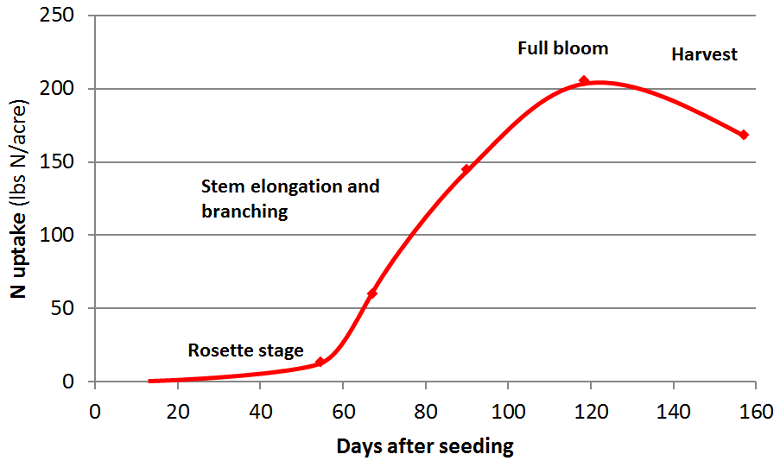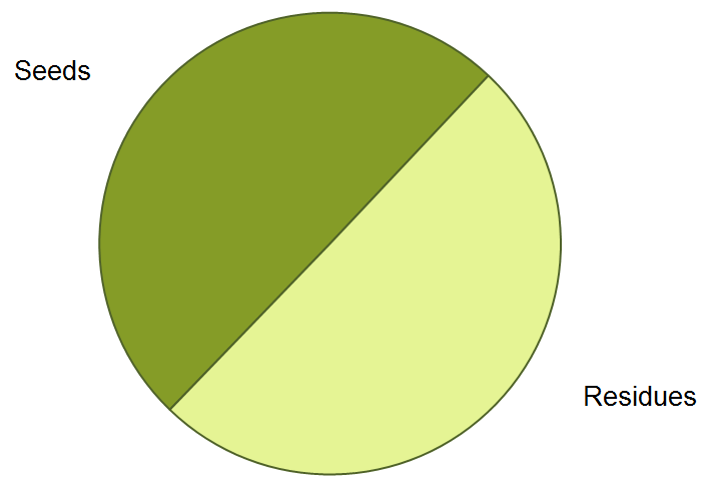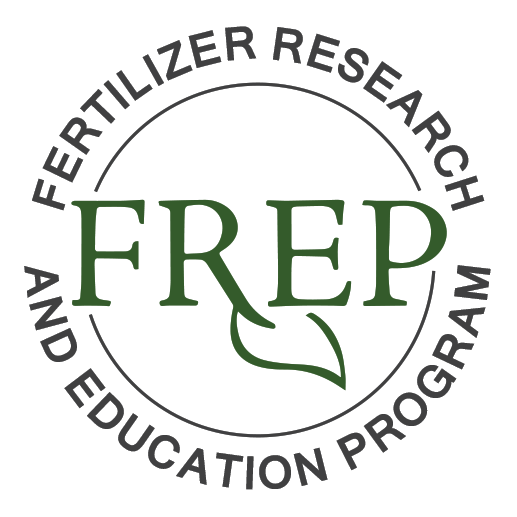Safflower Nitrogen Uptake and Partitioning
Seasonal N Uptake

Nitrogen uptake in irrigated safflower in Yolo County. Seeding rate was 25 lbs/acre. The field was fertilized with 175 lbs N/acre and the average yield was about 2500 lbs/acre. Safflower takes up N slowly during the rosette stage, until about a month after emergence. Growth and uptake is rapid during stem elongation and branching. After flowering, during the grain filling period, most of the N is translocated from the vegetative parts to the grain and N is no longer taken up [1,6].
Nitrogen Partitioning

Nitrogen distribution in safflower plants grown in Yolo County from 1994-1995. "Seeds" indicates the harvested shells and kernels, or achenes. On average, 50% of total safflower N was allocated to the harvested seeds. Nitrogen partitioning can vary with year, location and variety [1].
Nitrogen Removed at Harvest
Nitrogen removed with harvested safflower seeds. "Seeds" refers to the achenes (kernel+hull). The overall average is weighted for the number of observations in each trial. More information can be found here href="#References">[3].
| Location | Years | Removal (lbs N/ton at 8% moisture) | Source | |
|---|---|---|---|---|
| Mean | Range | |||
| California | 1994-95 | 48.8 | 34.8-58.6 | [1] |
| Montana | 1977-78 | 63.1 | 48.9-71.2 | [5] |
| Montana | 2000-03 | 59.5 | 57-63.7 | [8] |
| Various | 1967 | 54.9 | 45.3-66.2 | [4] |
| Greece | 1998-99 | 77.2 | 47.2-109.3 | [7] |
| Greece | 2004-05 | 40.6 | 33.8-45.7 | [2] |
| Iran | 2013-14 | 49.0 | 36.6-59.4 | [9] |
| Various | 49.2 | [10] | ||
| Weighted Average | 56.8 | 33.8 - 109.3 | ||
Links
References
- Cavero, J., Plant, R.E., Shennan, C., Friedman, D.B., Williams, J.R., Kiniry, J.R., Benson, V.W., 1999. Modeling nitrogen cycling in tomato-safflower and tomato-wheat rotations. Agricultural Systems 60, 123-135. Complemented with unpublished data.
- Dordas, C.A., Sioulas, C., 2009. Dry matter and nitrogen accumulation, partitioning, and retranslocation in safflower (Carthamus tinctorius L.) as affected by nitrogen fertilization. Field Crops Research 110, 35-43.
- Geisseler, D., 2016. Nitrogen concentrations in harvested plant parts -A literature overview. Report to the Kings River Watershed Coalition.
- Guggolz, J., Rubis, D.D., Herring, V.V., Palter, R., Kohler, G.O., 1968. Composition of several types of safflower seed. Journal of the American Oil Chemists Society 45, 689-693.
- Haby, V.A., Black, A.L., Bergman, J.W., Larson, R.A., 1982. Nitrogen fertilizer requirements of irrigated safflower in the northern Great Plains. Agronomy Journal 74, 331-335.
- Kaffka, S.R., Kearney, T.E., 1998. Safflower production in California. University of California Agriculture and Natural Resources Publication 21565.
- Koutroubas, S.D., Papakosta, D.K., Doitsinis, A., 2004. Cultivar and seasonal effects on the contribution of preanthesis assimilates to safflower yield. Field Crops Research 90, 263-274.
- Lenssen, A.W., Waddell, J.T., Johnson, G.D., Carlson, G.R., 2007. Diversified cropping systems in semiarid Montana: Nitrogen use during drought. Soil & Tillage Research 94, 362-375.
- Shahrokhnia, M.H., Sepaskhah, A.R., 2016. Effects of irrigation strategies, planting methods and nitrogen fertilization on yield, water and nitrogen efficiencies of safflower. Agricultural Water Management 172, 18-30.
- United States Department of Agriculture Natural Resources Conservation Service. Crop Nutrient Tool.

